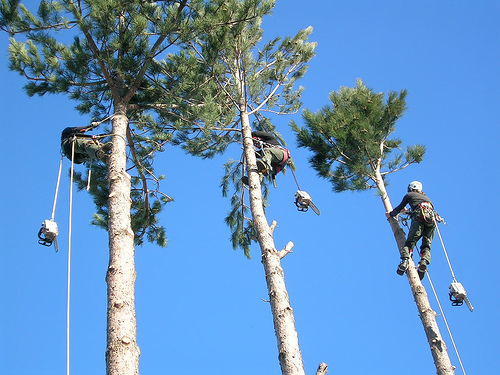Maintain a chainsaw
This unit standard is designed for professional users of chainsaws in the forestry and other industries. People credited with this unit are able to: demonstrate knowledge of the chainsaw cutting unit; sharpen a chainsaw chain; and maintain a chainsaw power unit.
Contents
This unit is used in the following courses
Demonstrate knowledge of the chainsaw cutting unit
<kaltura-widget kalturaid='292775' size='M' align='L'/>
- Cutting unit components are identified by name and function.
Range: cutters (left and right), side straps, drive tangs, rivets, depth gauges.
- Cutter profiles and uses are described.
Range: chisel, semi chisel.
- Sprocket types are explained in terms of their characteristics.
Range: spur, rim.
- The terms pitch and gauge are explained in relation to a chainsaw chain.
- Cutting unit components that must be matched are explained.
Range: sprocket and chain for pitch, bar and chain for gauge.
- Filing tools for sharpening a chainsaw chain are described.
Range: jointing tool, file guide, stump vice, callipers, file, file handle.
- Chainsaw bar configurations are described in terms of maintenance requirements.
Range: solid nose, sprocket tip.
- Cutting unit faults are described and means to rectify explained.
Range: uneven cutter lengths and angles, incorrect chain tension, chain wear, insufficient lubrication, worn drive and nose sprocket, incorrect depth gauge settings, damage and/or wear to the guide bar.
- Periodic maintenance requirements of a chainsaw cutting unit are explained.
Range: sprocket replacement, bar dressing.
- Requirements for running in a new chain are explained.
Sharpen a chainsaw chain
- Chain cutter condition is evaluated during use for cutting efficiency.
- Safe maintenance area is selected, clear of tree felling, moving logs, ropes or machinery, and clear of other workers.
- Chain is consistently sharpened, on the saw, to manufacturer’s recommendations.
Range: correctly tensioned, correct file size, use of filing aids as required, uniform cutter length, filing angles, depth gauge settings.
- Sharpened chain is tested.
Range: straight cuts, smooth cutting, cutting efficiency.
Maintain a chainsaw power unit
- Maintenance intervals recommended by manufacturer are stated.
Range: daily, periodic.
- Chainsaw is prepared for daily maintenance.
Range: cutting unit and covers are removed.
- Tools suitable for each maintenance task are identified and correctly used.
- Components are checked, cleaned, maintained or replaced according to manufacturer’s recommendations.
Range: filter, inverting bar, power head, cutting unit, visual check for wear, damage or security.
- Chainsaw is reassembled and adjusted according to manufacturer’s recommendations.
- Periodic maintenance requirements of a chainsaw power head are explained in accordance with manufacturer’s recommendations.
Range: clean or replace - filters, spark plug; service - starter mechanism, clutch, fuel and oil tanks, cooling system, ignition system.
- Need for specialist repairs beyond the scope of field maintenance is recognised as required.
Notes
- Legislation relating to this unit standard will usually include law relating to Health and Safety in Employment. In New Zealand for example, it is the Health and Safety in Employment Act (1992) and any subsequent amendments.
- This resource refers to the Approved Code of Practice for Safety and Health in Forest Operations published by the Occupational Safety and Health Service, Department of Labour, Wellington (1999) and any subsequent amendments.
- Reference to industry best practice in this unit standard refers to minimum standards for forest operations as described in: Forest Industry Best Practice Guidelines, published by Forest Industries Training (2000) and available from Forest Industries Training, PO Box 6216, Rotorua; and the environmental standards contained in the Forest Industry Code of Practice published by the Logging Industry Research Organisation (LIRO) (1993) and available from LIRO, Private Bag 3020, Rotorua. The purpose of these documents is to plan, manage and carry out forestry operations in a manner which is sustainable, environmentally and socially acceptable, physically achievable, and economically viable.
